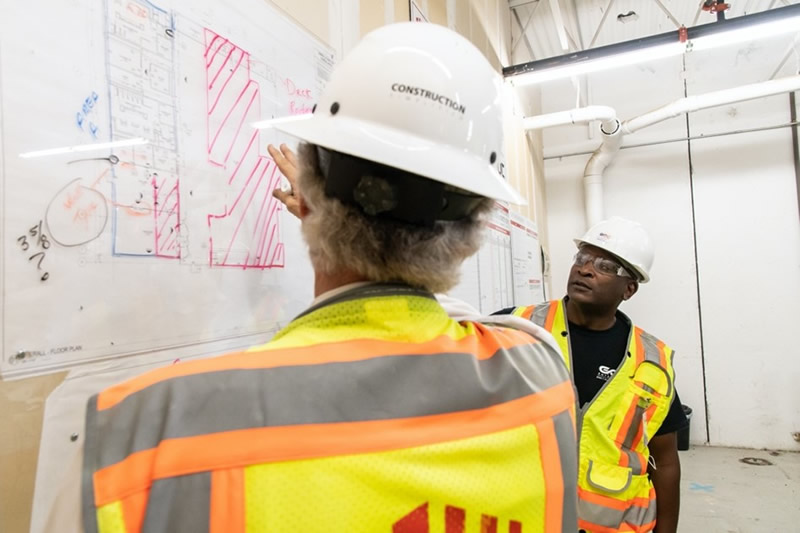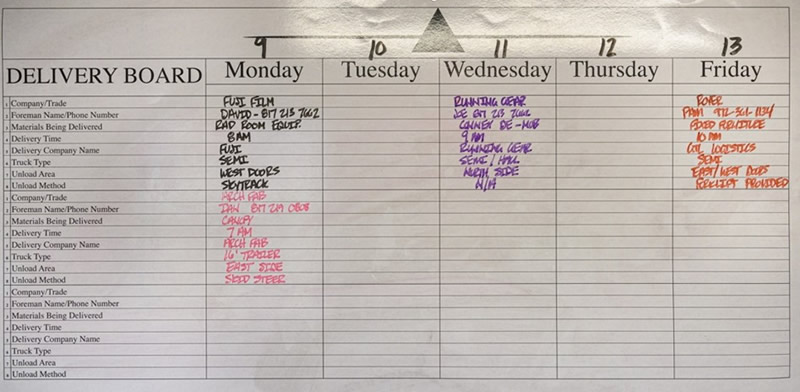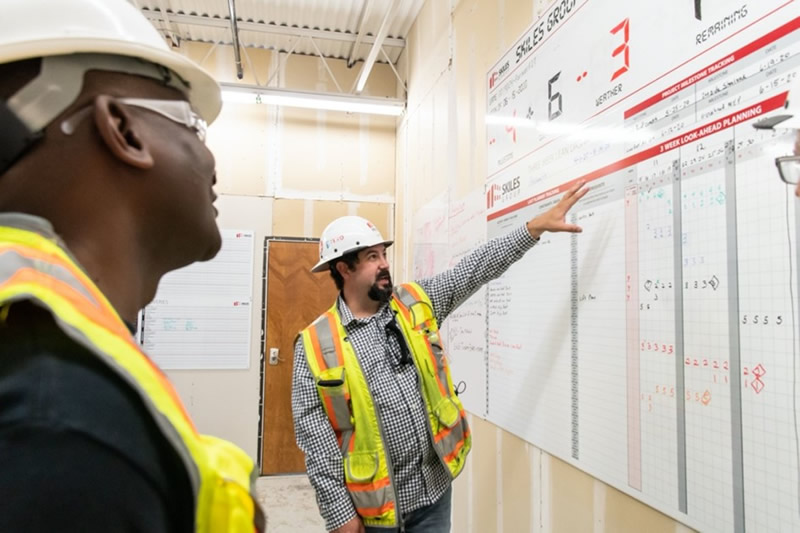6 Visual Communication Tools to Make Your Jobsite a Visual Workspace
Visual communication is such an intricate part of establishing and maintaining a reliable workflow in the field. When communication breaks down in the field on a jobsite, teams experience loss of productivity, hindered completion times, and costly errors. Visual communication tools significantly help bridge communication gaps and facilitate better trade to trade collaboration at the daily huddle. It will also help build accountability amongst all team members.
Here are six ways you can make your jobsite a visual workspace:
-
Floor Plans/Elevations Under Laminate + Dry Erase Markers
Purchase clear laminate and a pack of dry erase markers with multiple colors. Designate a different color marker per trade. Place floor plans and elevations under laminate and have trade partners verbally and visually show the entire team where they are working during the daily huddle. This is one of the simplest ways to visually communicate all planned activities with all construction trades on the jobsite and will decrease the chances of rework due to trades not knowing where work is taking place.
-
Material Delivery Board
Material delivery visual boards are a great way to ensure that project deliveries are “just in time,” which is a system for producing or delivering the right amount of materials or product at the time it is needed for installation.
Create a weekly dry erase calendar board that has each day of the week shown and enough space to accommodate multiple deliveries. The material delivery board should be used to help the trades answer the following questions:
-
- What is being delivered?
- What time is it being delivered?
- What company is delivering it?
- What type of truck is it coming in?
- Where will it be unloaded?
- How will it be unloaded? (hand/crane/lift/etc.)
By communicating this information visually, it allows all team members to know the logistics of building materials coming onto the site and can potentially avoid many of the 8 wastes.
-
Inspection Board
Inspection boards can help everyone onsite know when project inspection dates are occurring and what the current status is, which can help with productivity onsite. Create a weekly dry erase calendar board that has each day of the week shown and enough space to accommodate multiple inspections. The inspection board should answer the following questions:
-
- What is the inspection/what is being inspected?
- Who requested the inspection?
- What date/time was the inspection requested?
- What date/time will the inspection occur?
- What are the results (pass/fail)?.
-
Constraint Board
A constraint board is a powerful visual tool that can help the team to communicate, prioritize, and track the constraints that arise during construction. When creating a constraint board be sure to list the following.
What/Where?
When a last planner brings up a new constraint in the daily huddle, it is important to not get too deep in the details of the constraint at first. The huddles are fast-paced, and a lot of time can be spent while describing a constraint and its implications. It is best to just fill out the what column to start and have the team move on. When the huddle is over and the constraint is explored further, more details around what and where can be added for clarity.
Who/When?
The who and when columns must be filled out at the huddle with the last planners. This is the commitment portion of the constraint board; assigning the responsibility for resolving a constraint to someone and having that person make a commitment about when it will be resolved adds strong layers of accountability to the team. This is needed to effectively help the workflow downstream, allowing for the team members to plan and commit with confidence.
-
Three Week Look-A-Head Board
A Three Week Look-Ahead board, will allow trade partners to fill out weekly work plan activities, manpower tracking, and constraints on a visual board in their own dry erase color. Once populated the construction superintendent should be able to review each week and ensure the following questions are true:
- Are all the activities workable?
- Will the team understand what is required?
- Will the team understand what is needed from others?
- Are activities achievable within the planned period?
If the answer is No to any of these questions, the trade partner foreman must revise what has been written. Every day at the daily huddle the last planners will read what activities they are working on and state what current manpower they have for implementing it. They should then be able to show the team on the floor plans under laminate.

-
Percent Plan Complete Board
The Percent Plan Complete board will track the score of how well the team is keeping their commitments to one another. The Percent Plan Complete board can be printed on plotter paper or drawn onto a whiteboard; either way, it should be displayed where you will be having your daily huddles. You can build your Percent Plan Complete board with the following categories:
- Activities Completed
- Activities Promised
- Weekly Team Percentage
- Root Cause Categories
- Root Causes for Work Missed
- Twelve-Week Snapshot
After your final huddle of the week, tally up the number of activities completed and divide by the number of the activities promised. This will yield a percentage of commitments met.
You can also track root causes for work that was not completed as part of your root cause analysis. Predetermined root causes for missed commitments are:
- Weather,
- Manpower,
- Machinery,
- Design,
- Make-ready,
- Materials,
- Poor scheduling, and
- Other
A root cause pie chart can be a great way visually understand what categories the root causes are coming from. And by dividing the number of root cause types by the number of missed commitments, you will have the root cause percentage by type. This helps to identify trends on the project, such as manpower shortages, slow design response times, and weather impacts.
Final Thoughts
As you start adopting the use of these visual communication tools to improve construction project management, I am sure you’re going to find other areas that could benefit from boards.
Make sure that the visual tools you create for improving communication on the jobsite are easy to understand, set up and use and that the tools are clearly visible. At the same time, you should be able to maintain them regularly.
If you have some other ideas about how to make your jobsite visible, share in the comments below.









